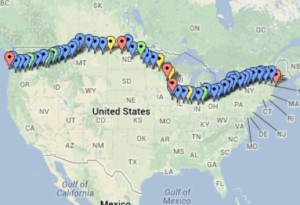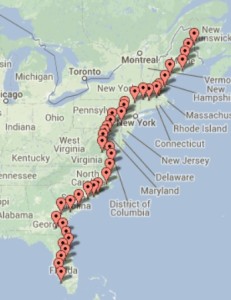If you had an opportunity to go on a long-distance bicycle tour, where would you go? And which route would you take?
 Much to my surprise, I got that opportunity. When I left a job in 2010 and married Debbie, we cycled across America on our extended honeymoon. Two summers later, we bicycled from Florida to Maine on our Mom-to-Mom tour. We wouldn’t trade those experiences for anything.
Much to my surprise, I got that opportunity. When I left a job in 2010 and married Debbie, we cycled across America on our extended honeymoon. Two summers later, we bicycled from Florida to Maine on our Mom-to-Mom tour. We wouldn’t trade those experiences for anything.
 Adventure Cycling Association publishes maps specifically designed for bicycle tourists. They’ve taken much of the hard work out of navigation and local route selection to maximize your experience. You’ll need to decide what type of experience you’d like and what general areas you’d like to travel. Then, you’ll be left with a few options to choose from.
Adventure Cycling Association publishes maps specifically designed for bicycle tourists. They’ve taken much of the hard work out of navigation and local route selection to maximize your experience. You’ll need to decide what type of experience you’d like and what general areas you’d like to travel. Then, you’ll be left with a few options to choose from.
Debbie and I began our first tour in Oregon, following ACA’s Lewis and Clark Trail along the Columbia River valley. After two weeks, we merged with the Northern Tier route in Montana, which we followed for the remainder of our trek.
In 2012, we began in Naples, Florida, traveled across the State of Florida following part of ACA’s Florida Connector route, and then merged with the Atlantic Coast route until the final days of our tour in Maine.
I thought it might be useful to you, with Debbie’s help, to compare our tours. Below is some commentary on some major categories you might want to consider in your selection process. We then share our rankings of each on a scale of 1 to 5 (5 is best). This information will give you a flavor for what these routes have to offer.
1. Distance. The first determinant of your route selection will be its distance. How much time do you have available, and what speed do you anticipate traveling? Will you get bored with long distances, or does the challenge intrigue you? We had no clue how fast we would travel when we began our first trip. With only two months available for the tour, we traveled 3,500 miles in 63 days (including rest days), and received assistance from some friends and family for roughly 400 miles. Even so, we were a couple of days late returning. Our second tour was about 2,600 miles over 47 days.
Coast-to-coast: Debbie 5, Tim 5
Atlantic Coast: Debbie 4, Tim 4.
2. Terrain. Are you up for some climbing, or do you prefer flat straightaways? Our two routes had both. The Atlantic Coast tour was extremely flat until we arrived in Virginia, about halfway into our trip. The flat terrain made for an easy transition to a more strenuous daily physical schedule. On our coast-to-coast tour, we climbed more hills, and higher mountains. Tough first-week climbs in Oregon surprised us. Once on the Northern Tier, we enjoyed flat land for weeks. But don’t think the Atlantic Coast tour doesn’t have challenging hills. One steep ascent along the Susquehanna River in Pennsylvania sent us whimpering to an area motel.
Coast-to-coast: Debbie 5, Tim 5
Atlantic Coast: Debbie 5, Tim 4.
3. Traffic. There’s no doubt about it. The Atlantic Coast tour had much more traffic. After all, we were traveling through more densely populated regions, although that’s not to say that all of the cycling was in congested areas. Traffic hot spots were Florida’s Route A1A from the coast to Yulee at rush hour, narrow roads in Maryland, clogged traffic around Fredericksburg, Virginia, and jam-packed shoulder-less roads by Sebago Lake in Maine.
Coast-to-coast: Debbie 5, Tim 4
Atlantic Coast: Debbie 2, Tim 3.
4. Aesthetics. If you love grand vistas and wide open spaces, you’ll want to bicycle through the Rocky Mountains and the Plains States. If you prefer ocean, the Atlantic Coast will give you more of it, although not as much as the tour’s name would imply. There’s plenty of beauty on the Atlantic Coast tour, but I don’t think it compares with the coast-to-coast experience, which also included a visit to Niagara Falls. Throw in more beautiful sunsets, and the coast-to-coast aesthetics are clearly superior.
Coast-to-coast: Debbie 5, Tim 4
Atlantic Coast: Debbie 4, Tim 3.
5. Weather. Which do you prefer, tornados or hurricanes, mid-90s with humidity and torrential rain, or dry heat and a bit more moderate weather? Thankfully, we didn’t run into violent weather, although it was threatening us a few times. We’ll not let the actual weather we experienced on our tours influence our rankings, which we are basing on typical midsummer weather patterns. The Northern Tier will offer you much less humidity and cooler temperatures overall.
Coast-to-coast: Debbie 5, Tim 5
Atlantic Coast: Debbie 3, Tim 3.
6. Services. You’ll want to ask yourself which is better for you: many services or few? Depending upon your interests, you may prefer the adventure of remote areas, or the convenience of more active spots. We’ll consider services to be stores, motels, campgrounds, and bicycle shops. Our rankings are based on adequacy of services. Both routes had long stretches without various services, but the Atlantic Cost tour clearly offers more services. Yet, their motel accommodations are more expensive. If you prefer camping in the wild, you won’t find much of that on the Atlantic Coast tour.
Coast-to-coast: Debbie 4, Tim 3
Atlantic Coast: Debbie 5, Tim 4
7. Safety. This is a difficult category to rank because it is so subjective. We’ll take into account animals, humans, and traffic, and the extent to which any of them could have posed threats to us. Since we had no crises on either tour, we’re going to give you “impression votes” based on how we felt. Anecdotes from locals on crime or other incidents influence our votes. We heard reports of crime areas on both routes, which we sensed anyway as we traveled. Traffic alone tips the scale for me.
Coast-to-coast: Debbie 4, Tim 4
Atlantic Coast: Debbie 3, Tim 3
8. Other factors. If you’re like us, when you go on a bicycle tour, you want to see and experience new places. Our familiarity with portions of the Atlantic Coast region would work against it on this survey, but we’ll not penalize it in the scoring. You’ll want to factor into your decision which areas you haven’t seen yet–and which you’d like to see. Each route passed through regions with plenty of history. The Atlantic Coast had more history because of the relative age of its settling, and the density of its population. If you like history, consider traveling through the likes of St. Augustine, Williamsburg, Richmond, and Washington. A stop at Mount Vernon and cycling right up to the Lincoln Memorial will please any history buff. And if you like to explore major cities, there are more side trips on the Atlantic Coast route to major cities like Savannah, Charleston, Washington, Baltimore, Philadelphia, New York, and Boston. Major cities on our coast-to-coast tour were Portland, Oregon, Minneapolis, Cleveland, and Buffalo. There are also cultural differences. You can sense the Southern culture versus the more metropolitan areas further north on the Atlantic Coast tour. The Northern Tier route lets you experience the West. It also has its own built in history lesson along the Erie Canal. You’ll travel to many states on either tour, but only the Northern Tier offers travel across the border into Canada–it’s a real plus when you can cycle to the brink of Niagara Falls!. And there’s something about bicycling from one coast of the United States to the other that makes it hard to top!
Coast-to-coast: Debbie 4, Tim 4
Atlantic Coast: Debbie 5, Tim 4
The composite score (equal weighting for each) comes in as follows:
Coast-to-coast: Debbie 4.625, Tim 4.25
Atlantic Coast: Debbie 3.875, Tim 3.5
You might also find these articles helpful:
Top 5 Place on Cross-country Bicycle Tour
The Best of the Atlantic Coast Bicycle Tour
But don’t take our word for it. Venture out yourself, and please let us know what you thought!
